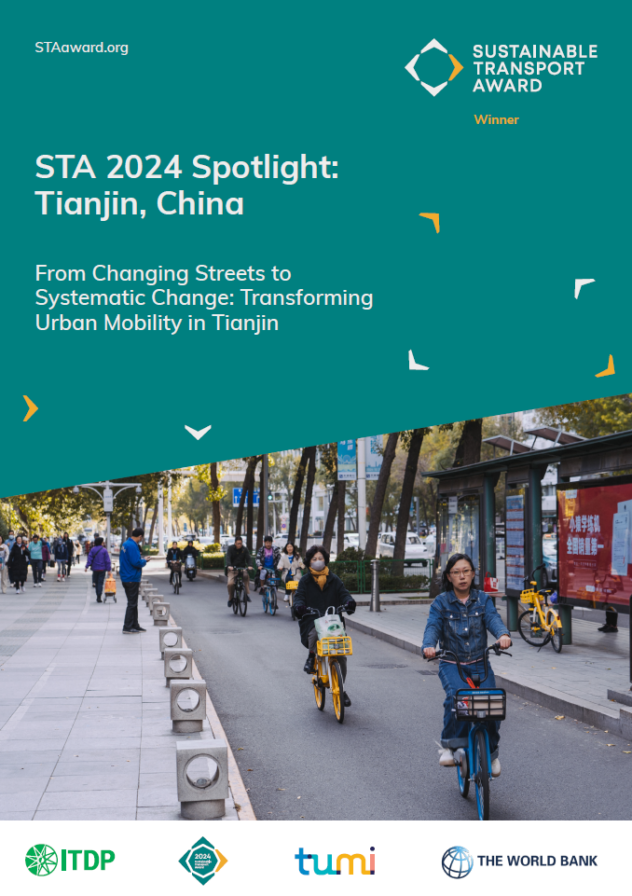2024: Tianjin, China
The expansion of bikeshare systems in Tianjin help to make cycling more accessible to all. Image: TheCityAtEyeLevel.com
In 2024, the STA program recognized Tianjin for the city’s collaborative efforts to expand non-motorized transport (NMT) and street infrastructure that enhances walking and cycling connections to public transport. According to Climate Watch, China’s transport-related CO2 emissions alone account for 11% of all global transport-related emissions. As one of the country’s most populated cities, Tianjin is home to more than 13 million people and urgently needs to reshape its approach to mobility in order to address high emissions. Thus, the city’s recent investments into sustainable mobility policy and infrastructure have the potential to serve as a model for the rest of China as the nation works towards achieving carbon neutrality before 2060.
In the year prior to their nomination, Tianjin had improved access to around 96 metro stations with enhancements to various walking, biking, and bus networks. This project implemented intersection improvements and connected facilities such as bike parking, bus terminals, green landscaping, and more. The city also developed a new bus terminal with off-street and vertical bus parking to serve up to seven bus routes. An impressive network of 190 roads totaling 132 kilometers also received streetscape improvements prioritizing walking and cycling connections.
Improvements included pavement updates, drainage fixes, and the redesign of street layouts to better separate NMT modes from motor vehicles. Many facilities for more active mobility, including bike parking, sidewalk guardrails, and improved street lighting, were also implemented on several city roads. Nearly 216,000 square meters of bike lanes were repaved with polymer for clear separation, with 82.4 kilometers of rails installed to separate lanes.
Over 605,000 square meters of pedestrian sidewalk networks were repaired or constructed, with more than 3,500 street-level trees and over 280 street lights newly installed. The significance of the project is immense – thus far, it is the most significant project supported by the World Bank (by USD$ value and quantity of infrastructure delivered) dedicated to improving streets for walking, cycling, public transport, and green space.
So far, Tianjin’s impressive efforts have also influenced local and national policy. The learnings from the city’s studies, processes, and intervention in the past year and a half — notably under COVID-19 pandemic restrictions — have informed the design of national pedestrian and bicycle system planning standards. The impacts are also being seen in people’s commuting behaviors: the modal share for walking, biking, and public transport grew to more than 70% of the city’s total mode share in 2022. This helps support Tianjin’s aims of becoming a model for green urban development, especially as as other global cities work to reshape and rethink their car-focused environments. The STA program proudly recognize Tianjin as the 2024 STA winner for these commitments and visionary actions.
Tianjin was joined by one STA honorable mention in 2024: the City of Peshawar, Pakistan.
In the past year, the City of Peshawar and its transport authority TransPeshawar implemented an innovative Bus Industry Restructuring Program (BIRP), which involved off-boarding more than 500 outdated and fuel-intensive public transport vehicles and replacing them with clean technology vehicles to facilitate a smoother industry transition. The BIRP initiative is part of a broader effort in Peshawar to improve air quality and reduce greenhouse gas emissions by focusing on road and passenger transport impacts.
Peshawar was previously recognized as an STA honorable mention in 2022 for their work on Zu Peshawar, the first Gold Standard BRT on the Indian Peninsula, which has placed a notable focus on providing access to marginalized communities, such as women, persons with disabilities, and children. Peshawar now aims to have fleets of fully electric buses that will cover 75% of the city, helping to reduce issues of chronic congestion and high emissions.


